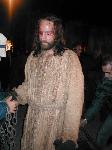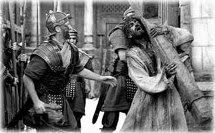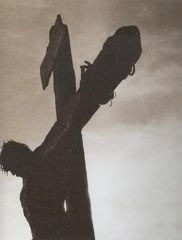Three Nails, a Camera and a Cross: On the Set of Mel Gibson´s ´The Passion´
ROME — "Okay, cameras are rolling! Silence, please!" shouts the production assistant. Mel Gibson is staring intensely at the monitors in front of his director´s chair at Rome´s Cinecittà Film Studios. Actor Jim Caviezel (High Crimes, Count of Monte Cristo, The Thin Red Line) is dressed only in a loincloth. His arms are shackled to a low, granite pillar and he is dancing about in his bare feet on the cold pavement in order to keep warm between shots. "The Scourging at the Pillar!" comes the voice again. "Scene 2! Take 3!"After five hours of makeup, Caviezel´s body is an oozing mass of lacerations and open wounds, a scary - and realistic - representation of a Roman flagellation. "Aaaand … ACTION!"
In spite of his long and successful career, Gibson isn´t treating The Passion like just another movie; it is the fruit of his unique spiritual experience - it´s his baby."I have meditated a lot on the passion of Our Lord," he told the Register. "When I was 35, I started praying the Prayers of St. Bridget and they really helped me understand what the passion was all about. Now I want to share it with others."
Last June, Gibson hand-picked the 34-year-old Caviezel to play the role of Jesus Christ. For the last six months, Gibson has been in Italy shooting a different kind of film. The Passion will show the final hours of the life of Jesus - from the Last Supper to the Resurrection.And this movie will be quite different from anything Gibson - or any director - has ever done before: It is a Catholic film, starring a Catholic actor, about the quintessential Catholic subject.
In his Inperson interview with the Register last year, Caviezel showed what might have made him a candidate for the role. "There was a point in my life when I got tired of being mediocre," he said. "So I started praying the rosary really from my heart, not just lip service. The next day I went through this horrible darkness inside. It was very painful, like a purging process."After I went through it, I said, ´If this is what will be necessary to get closer to God, I will go through it.´" It was important training for his new role. Gibson wants realism, above all. He is striving for a perfect reproduction of the passion - from the ancient languages spoken at the time of Jesus right down to the bloody wounds.
Blow by blow
Standing behind Caviezel in the scourging scene are two Italian actors dressed as Roman soldiers. They are using authentic-looking whips studded with sharp metal chunks to scourge Caviezel. During the editing phase, the impact of each strike on Caviezel´s back will be digitally added.One of the acting coaches is standing off-camera with a couple blocks of wood, calling out the cadence for the whippings.When the shooting begins, the coach claps the two blocks together loudly in unison with each blow of the soldier´s whip."Three, two, one, CLAP. Three, two, one, CLAP," the coach screams out, throughout the scene.At each clap, Caviezel´s body jerks forward, mimicking the pain that Christ must have felt with each strike.One camera catches the Roman soldiers and their helpless victim. Another zooms in for a close-up on Caviezel´s face as he reproduces the horror of each lashing.
Although The Passion might be considered too graphic for younger age groups, Gibson isn´t pulling any punches when it comes to showing the reality of Jesus´ suffering."There is no gratuitous violence in this film," Gibson said. "Understanding what he went through, even on a human level, makes me feel not only compassion but also a debt: I want to repay him for the enormity of his sacrifice."Behind the CamerasWhile it seems simple enough, the scourging scene took six full days to shoot, in large part because of Gibson´s minute attention to details - a hallmark of the films he directs."He might have to repeat a mundane shot 50 times, but the minute he sees a good take, he doesn´t have to think twice. He just knows instinctively what will look good and what will look bad on film," says Jesuit Father William Fulco, the film´s Semitic-language expert.
At this point in his career, Gibson´s talent as an actor and director goes uncontested. But he is unique among Hollywood´s mega stars because he hasn´t allowed his fame to get to his head.When a young actor asks for advice, Gibson is more than willing give him a few pointers. Between shots, he is often seen chatting with the extras. And he refuses to ride in the back seat of his black Mercedes, preferring to sit up front and chat with his chauffeur, Fabio.Then there´s the spiritual side of Gibson that few people see. He had a makeshift chapel installed on the set and goes to daily Mass, often joined by Caviezel and other crew members. He isn´t afraid to share his faith with friends and co-workers. And even after a long day, he always makes time for his wife and children (he has seven) when he gets home.
Spiritual Impact
Although the major film distributors are, for the time being, politely keeping their distance from The Passion, Gibson has brought along a "coalition of the willing" from Hollywood and has no shortage of volunteers.Bruce Davey, Gibson´s partner at Icon Productions, is fully supporting the film. One of the best cameramen in the business, Caleb Deschanel, is on board (The Natural, The Right Stuff, The Patriot). And Gibson has tapped his longtime friend Steve McEveety (Braveheart, We Were Soldiers) as his producer.What´s more, the film crew of The Passion is not exclusively comprised of Christians. Members of the Jewish, Muslim and Buddhist religions also form an integral part of Gibson´s team.And the film is already reaping spiritual fruit, which in Gibson´s mind is much more important than monetary returns."It´s about changing lives and changing hearts," he says.
One of the Italian actors has come back to the sacraments after a long hiatus. He now joins Gibson and his family for Sunday Mass. Another member of the film crew, an atheist, is exploring the Catholic faith.But they are not the only ones affected by this film. During the scourging scene, tears welled up in more than one crew member´s eye as the reality of Christ´s suffering came to life."The attitude on the set has totally changed since we began this film back in September," says McEveety. "People are more aware of the importance of kindness and working together - much more than I´ve seen on other productions I´ve worked on."Gibson concurs. "I think that the true horror of the passion will surprise people," he told the Register.
The Passion is due for release in April 2004.Gibson thinks the film will be a great success, in spite of Hollywood´s initial shyness toward the project. "I doubt they will give us an Oscar for it - it´s going to be a grass-roots thing - but it is still going to be a very good film and people will respond to it."And after all, what doth it profit a man to gain all the Oscars in the world if he loses his soul?
In spite of his long and successful career, Gibson isn´t treating The Passion like just another movie; it is the fruit of his unique spiritual experience - it´s his baby."I have meditated a lot on the passion of Our Lord," he told the Register. "When I was 35, I started praying the Prayers of St. Bridget and they really helped me understand what the passion was all about. Now I want to share it with others."
Last June, Gibson hand-picked the 34-year-old Caviezel to play the role of Jesus Christ. For the last six months, Gibson has been in Italy shooting a different kind of film. The Passion will show the final hours of the life of Jesus - from the Last Supper to the Resurrection.And this movie will be quite different from anything Gibson - or any director - has ever done before: It is a Catholic film, starring a Catholic actor, about the quintessential Catholic subject.
In his Inperson interview with the Register last year, Caviezel showed what might have made him a candidate for the role. "There was a point in my life when I got tired of being mediocre," he said. "So I started praying the rosary really from my heart, not just lip service. The next day I went through this horrible darkness inside. It was very painful, like a purging process."After I went through it, I said, ´If this is what will be necessary to get closer to God, I will go through it.´" It was important training for his new role. Gibson wants realism, above all. He is striving for a perfect reproduction of the passion - from the ancient languages spoken at the time of Jesus right down to the bloody wounds.
Blow by blow
Standing behind Caviezel in the scourging scene are two Italian actors dressed as Roman soldiers. They are using authentic-looking whips studded with sharp metal chunks to scourge Caviezel. During the editing phase, the impact of each strike on Caviezel´s back will be digitally added.One of the acting coaches is standing off-camera with a couple blocks of wood, calling out the cadence for the whippings.When the shooting begins, the coach claps the two blocks together loudly in unison with each blow of the soldier´s whip."Three, two, one, CLAP. Three, two, one, CLAP," the coach screams out, throughout the scene.At each clap, Caviezel´s body jerks forward, mimicking the pain that Christ must have felt with each strike.One camera catches the Roman soldiers and their helpless victim. Another zooms in for a close-up on Caviezel´s face as he reproduces the horror of each lashing.
Although The Passion might be considered too graphic for younger age groups, Gibson isn´t pulling any punches when it comes to showing the reality of Jesus´ suffering."There is no gratuitous violence in this film," Gibson said. "Understanding what he went through, even on a human level, makes me feel not only compassion but also a debt: I want to repay him for the enormity of his sacrifice."Behind the CamerasWhile it seems simple enough, the scourging scene took six full days to shoot, in large part because of Gibson´s minute attention to details - a hallmark of the films he directs."He might have to repeat a mundane shot 50 times, but the minute he sees a good take, he doesn´t have to think twice. He just knows instinctively what will look good and what will look bad on film," says Jesuit Father William Fulco, the film´s Semitic-language expert.
At this point in his career, Gibson´s talent as an actor and director goes uncontested. But he is unique among Hollywood´s mega stars because he hasn´t allowed his fame to get to his head.When a young actor asks for advice, Gibson is more than willing give him a few pointers. Between shots, he is often seen chatting with the extras. And he refuses to ride in the back seat of his black Mercedes, preferring to sit up front and chat with his chauffeur, Fabio.Then there´s the spiritual side of Gibson that few people see. He had a makeshift chapel installed on the set and goes to daily Mass, often joined by Caviezel and other crew members. He isn´t afraid to share his faith with friends and co-workers. And even after a long day, he always makes time for his wife and children (he has seven) when he gets home.
Spiritual Impact
Although the major film distributors are, for the time being, politely keeping their distance from The Passion, Gibson has brought along a "coalition of the willing" from Hollywood and has no shortage of volunteers.Bruce Davey, Gibson´s partner at Icon Productions, is fully supporting the film. One of the best cameramen in the business, Caleb Deschanel, is on board (The Natural, The Right Stuff, The Patriot). And Gibson has tapped his longtime friend Steve McEveety (Braveheart, We Were Soldiers) as his producer.What´s more, the film crew of The Passion is not exclusively comprised of Christians. Members of the Jewish, Muslim and Buddhist religions also form an integral part of Gibson´s team.And the film is already reaping spiritual fruit, which in Gibson´s mind is much more important than monetary returns."It´s about changing lives and changing hearts," he says.
One of the Italian actors has come back to the sacraments after a long hiatus. He now joins Gibson and his family for Sunday Mass. Another member of the film crew, an atheist, is exploring the Catholic faith.But they are not the only ones affected by this film. During the scourging scene, tears welled up in more than one crew member´s eye as the reality of Christ´s suffering came to life."The attitude on the set has totally changed since we began this film back in September," says McEveety. "People are more aware of the importance of kindness and working together - much more than I´ve seen on other productions I´ve worked on."Gibson concurs. "I think that the true horror of the passion will surprise people," he told the Register.
The Passion is due for release in April 2004.Gibson thinks the film will be a great success, in spite of Hollywood´s initial shyness toward the project. "I doubt they will give us an Oscar for it - it´s going to be a grass-roots thing - but it is still going to be a very good film and people will respond to it."And after all, what doth it profit a man to gain all the Oscars in the world if he loses his soul?






